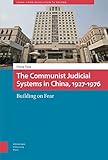The Communist Judicial System in China, 1927-1976 : Building on Fear / Qiang Fang.
Material type: TextSeries: China: From Revolution to Reform ; 3Publisher: Amsterdam : Amsterdam University Press, [2021]Copyright date: ©2021Description: 1 online resource (336 p.)Content type:
TextSeries: China: From Revolution to Reform ; 3Publisher: Amsterdam : Amsterdam University Press, [2021]Copyright date: ©2021Description: 1 online resource (336 p.)Content type: - 9789048554102
- Justice, Administration of -- History -- 20th century -- China
- Law -- China -- 20th century -- History
- Asian Studies
- East Asia and North East Asia
- History
- Law and society, sociology of law
- Political parties and party platforms
- Politics and Government
- Systems of law
- LAW / Government / General
- Fear, Communist Judicial System, Mao's China
- 347.51 23
- online - DeGruyter
| Item type | Current library | Call number | URL | Status | Notes | Barcode | |
|---|---|---|---|---|---|---|---|
 eBook
eBook
|
Biblioteca "Angelicum" Pont. Univ. S.Tommaso d'Aquino Nuvola online | online - DeGruyter (Browse shelf(Opens below)) | Online access | Not for loan (Accesso limitato) | Accesso per gli utenti autorizzati / Access for authorized users | (dgr)9789048554102 |
Browsing Biblioteca "Angelicum" Pont. Univ. S.Tommaso d'Aquino shelves, Shelving location: Nuvola online Close shelf browser (Hides shelf browser)

|

|

|

|

|

|

|
||
| online - DeGruyter Gabriel Lippmann's Colour Photography : Science, Media, Museums / | online - DeGruyter Myth and History in Celtic and Scandinavian Traditions / | online - DeGruyter The Macanese Diaspora in British Hong Kong : A Century of Transimperial Drifting / | online - DeGruyter The Communist Judicial System in China, 1927-1976 : Building on Fear / | online - DeGruyter Ecologies of Translation in East and South East Asia, 1600-1900 / | online - DeGruyter Fundamentals of Chinese Culture / | online - DeGruyter Archaeological Approaches to and Heritage Perspectives on Modern Conflict : Beyond the Battlefields / |
Frontmatter -- Table of Contents -- Acknowledgement -- Acronyms -- Introduction: Building on Fear -- 1. Born in Blood, 1927-1935 -- 2. Cornerstone or Aberration? 1935-1949 -- 3. From “Excessive Lenience” to Harshness, 1949-1951 -- 4. A Deliberate Purge, 1952-1953 -- 5. A Golden Age? 1953-May 1957 -- 6. The Great Leap of Law, June 1957-1965 -- 7. Not the Worst Period of Law, 1966-1976 -- Conclusion: From Party’s Fear to People’s Fear -- Bibliography -- Index
restricted access online access with authorization star
http://purl.org/coar/access_right/c_16ec
Drawing on hundreds of newly released judicial archives and court cases, this book analyzes the communist judicial system in China from its founding period to the death of Mao Zedong. It argues that the communist judicial system was built when the CCP was engaged in a life-or-death struggle with the GMD, meaning that the overriding aim of the judicial system was, from the outset, to safeguard the Party against both internal and external adversaries. This fundamental insecurity and perennial fear of loss of power obsessed the Party throughout the era of Mao and beyond, prompting it to launch numerous political campaigns, which forced communist judicial cadres to choose between upholding basic legal norms and maintaining Party order. In doing all of this, The Communist Judicial System in China, 1927-1976: Building on Fear fills a major lacuna in our understanding of communist-era China.
Mode of access: Internet via World Wide Web.
In English.
Description based on online resource; title from PDF title page (publisher's Web site, viewed 01. Dez 2022)


